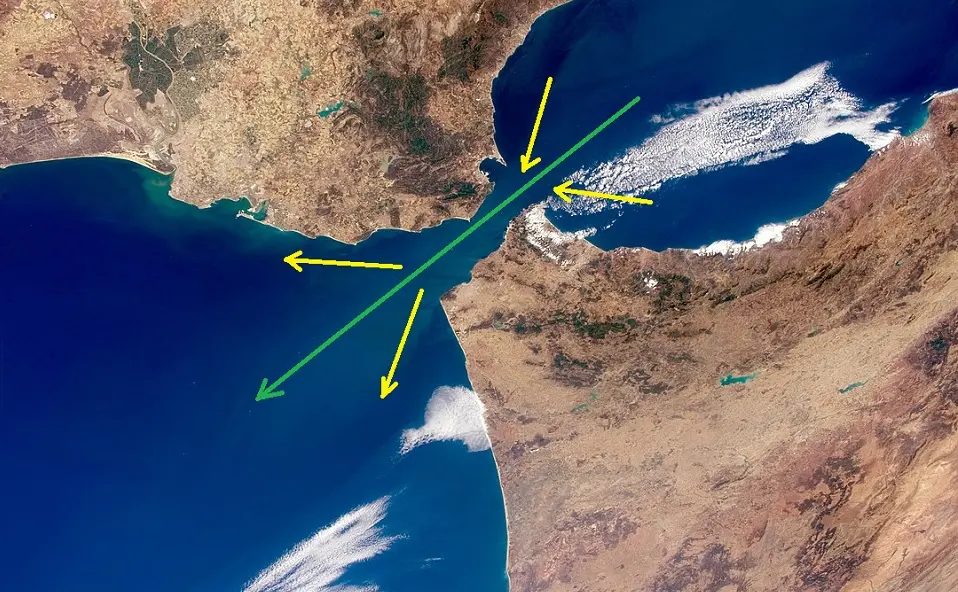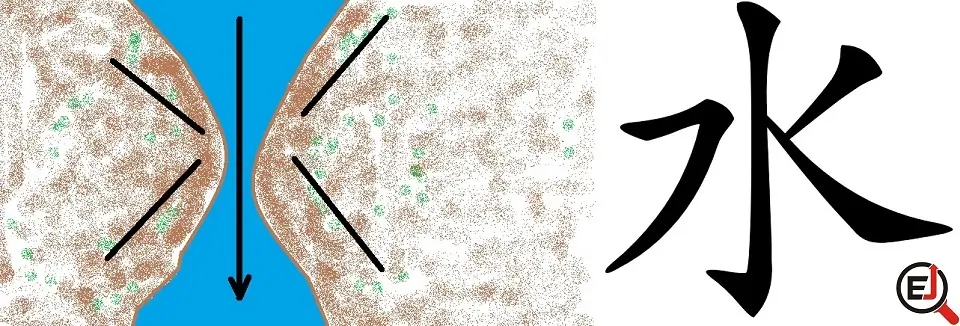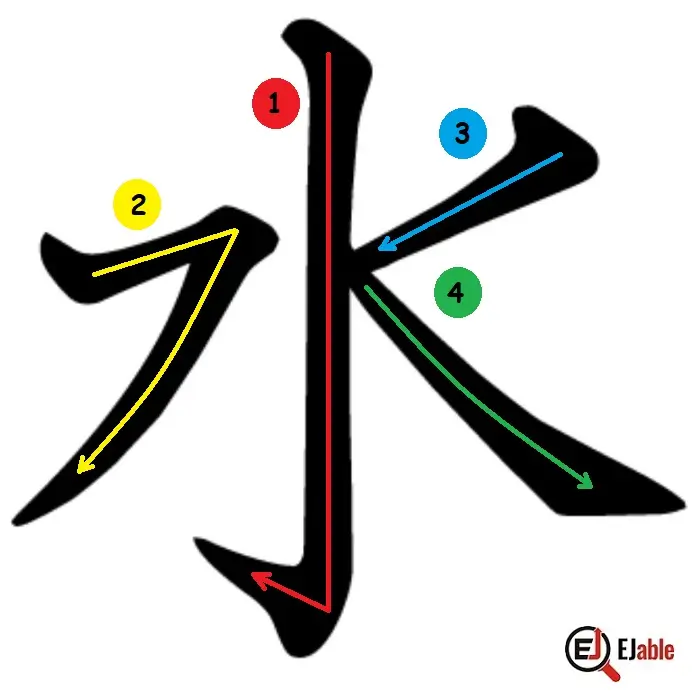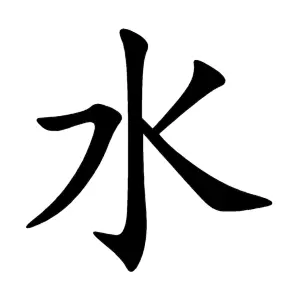Kanji for Water: 水 (Mizu)

The Japanese kanji for “water” is 水. The pronunciation of the Kanji 水 is “mizu” (みず) in its kun’yomi (Japanese reading) and “sui” (スイ) in its on’yomi (Chinese reading). The shape of this kanji is rather simple, and its shape has a clear origin.
The Kanji 水 is constructed with 4 strokes. This Kanji is a part of the JLPT N5 syllabus (please check the list of JLPT N5 Kanji). In Japanese schools, this Kanji is taught in grade 1.
Origin of the Shape 水 to Represent Water
The shape of the kanji 水 is derived from a pictogram of flowing water. The original form shows a mainstream with smaller tributaries branching off of it. Over time, this pictograph has been simplified to its current form.
Mnemonic: How to Remember the Kanji of Water (水)


We can remember the shape of the Kanji of water representing the characteristic of water, or any less viscous liquid, being able to flow and pass through openings, distinguishing it from solids.
Consider a wide stream of water reaching a narrow passage. The river stream will easily pass through the narrow passage and then spread again.
Stroke Order for the Kanji 水
The following illustrations show the stroke order to write kanji 水, meaning water (Mizu):




Water’s Symbolism and Cultural Significance
水 isn’t just a Kanji; it’s a symbol resonating with profound cultural significance. In Japanese culture, water is seen as the source of life and a symbol of purity, clarity, and calm. The Shinto religion, in particular, places significant emphasis on water in purification rituals.
Like many other cultures, water holds a great significance in Japanese thoughts. Some of the Japanese proverbs are a testimonial to this fact. A few examples of proverbs centered around water are as follows:
- 流れる水は腐らず (Nagareru mizu wa kusarazu) – “Flowing water does not rot.” This proverb emphasizes the importance of staying active and not becoming stagnant, both in life and in one’s thoughts.
- 川の流れと人生の行方 (Kawa no nagare to jinsei no yukue) – “The flow of the river and the course of life.” This saying draws a parallel between the continuous and sometimes unpredictable flow of a river and the journey of life.
- 水に流す (Mizu ni nagasu) – “Let flow in the water,” suggesting that one should forgive and forget past offenses or difficulties.
- 雨降って地固まる (Ame futte ji katamaru) – “After the rain, earth hardens.” This proverb suggests that difficulties or challenges (symbolized by rain) can lead to growth and strengthening (the hardening of the earth).
- 滴石を穿つ (Sekisui o ugatsu) – “Constant dripping wears away the stone.” This is similar to the English proverb “constant dripping wears away the stone,” emphasizing perseverance and the power of persistence over time.
- 海水を飲むような (Kaisui o nomu you na) – “Like drinking seawater.” This saying is used to describe a futile effort or an unsatisfying endeavor.
These proverbs showcase the depth of Japanese wisdom, often using elements of nature like water to convey life lessons and observations about human nature and experiences.
Water Kanji as a Radical and Component
the kanji for “water,” 水 (mizu), is frequently used as a radical in many other kanji characters. When used as a radical, it usually takes the form 氵or 氺, known as “さんずい” (sanzui), and it typically imparts meanings related to water or liquid.
Overall, Kanji 水 appears as a radical or as a component in 101 Kanji characters, including 20 Jōyō Kanji.
Examples of 水 as a radical
Following are some examples of kanji where 水 (water) appears as a radical:
- 江 (こう, kou): River, estuary.
- 汗 (あせ, ase): Sweat.
- 油 (あぶら, abura): Oil.
- 治 (じ, chi): Govern, regulate, heal.
- 泳 (およぐ, oyogu): Swim.
- 洋 (よう, you): Ocean, western style.
- 浮 (うく, uku): Float.
- 消 (きえる, kieru): Extinguish, disappear.
- 深 (ふかい, fukai): Deep.
- 清 (きよい, kiyoi): Pure, cleanse.
- 温 (あたたかい, atatakai): Warm.
- 湖 (みずうみ, mizuumi): Lake.
- 漢 (かん, kan): China, Chinese (often in the context of the Han dynasty).
- 潮 (しお, shio): Tide.
- 湿 (しめる, shimeru): Damp, wet.
These kanji characters utilize the water radical to convey meanings that are, in many cases, directly related to water, liquid, or concepts metaphorically associated with fluidity, purity, and change.
水’s Use in Language and Expressions
水 is used in various contexts in the Japanese language, not just to describe water itself but also in words that convey related concepts.
There are 599 Japanese words that begin with the Kanji 水, and it appears in 1239 words.
Examples of Kanji 水 in Compounded Kanji Characters
Following are the examples where Kanji for water appears in Japanese compounded Kanji characters:
- 水曜日 (すいようび, suiyoubi): Wednesday.
- 水中 (すいちゅう, suichuu): Underwater.
- 水素 (すいそ, suisou): Hydrogen.
- 水道 (すいどう, suidou): Water supply, waterworks.
- 水面 (すいめん, suimen): Water’s surface.
- 水泳 (すいえい, suiei): Swimming.
- 地下水 (ちかすい, chikasui): Groundwater.
- 湯水 (ゆみず, yumizu): Hot and cold water; used to imply something used without restraint.
- 水色 (みずいろ, mizuiro): Light blue; the color of water.
- 水分 (すいぶん, suibun): Moisture, liquid.
- 水球 (すいきゅう, suikyuu): Water polo.
- 水蒸気 (すいじょうき, suijouki): Steam, vapor.
- 水平 (すいへい, suihei): Horizontal, level with the water.
- 水力 (すいりょく, suiryoku): Water power, hydraulic power.
- 水田 (すいでん, suiden): Water-filled Paddy field (rice field).
These examples showcase the versatility of the kanji 水 in the Japanese language, extending from literal references to water to metaphorical and descriptive uses.
Conclusion
Water represents not just a substance but the fluidity of nature and life. The shape of the Kanji of water clearly indicates the way ancient people understood it as a symbol of change and adaptability.
Water’s kanji 水 is also common in Japanese names, both family and given names, for instance, in the surname 水野 (Mizuno). In given names like Izumi (泉), meaning “water fountain,” water’s Kanji is a component of the Kanji 泉.
In the art of Japanese calligraphy (書道, shodō), the Kanji of water 水 is often used for practice due to its simplicity yet potential for expressive brush strokes.
I am sure you will not find it difficult to remember this Kanji. You may also like to read about other Kanji characters on the page “How to Remember Kanji. “


A long-term ex-pat in Japan, Himanshu comes with an IT background in SAP consulting, IT Business Development, and then running the country operations of an IT consulting multinational. Himanshu is the co-founder and Managing Director of ReachExt K.K. and EJable.com. He is also an Advisory Board Member of a Silicon Valley AI/IoT startup.

